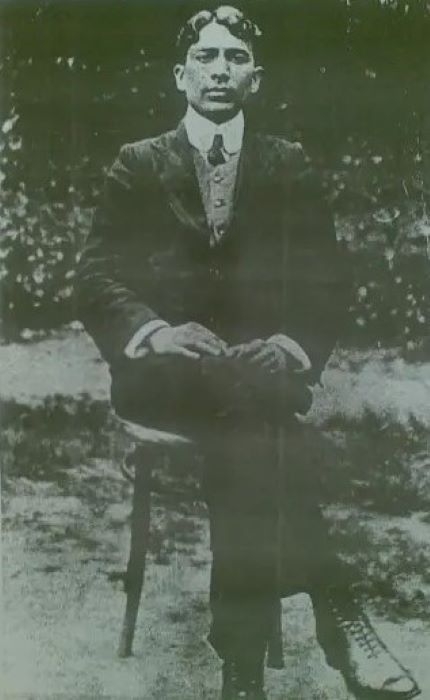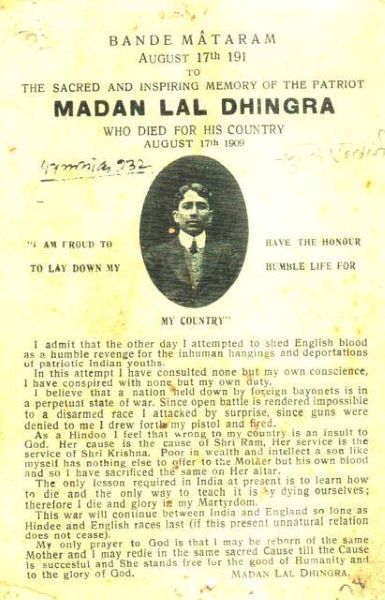Madan Lal Dhingra Age, Death, Family, Biography
Quick Info→
Religion: Hinduism
Death Cause: Execution By Hanging
Hometown: Amritsar
Some Lesser Known Facts About Madan Lal Dhingra
- Madan Lal Dhingra belonged to an affluent and educated family from Amritsar in Punjab, British India. His father was a chief medical officer who received the Rai Saheb title from the British government and all his brothers were educated abroad.
- As a student at Government College University (GCU) in Lahore, he became interested in the nationalist movement, focusing on home rule (swaraj) rather than independence.
- Dhingra was sensitive towards the poor economic conditions prevalent at the time in the country.
- He extensively researched the reasons for poverty and famine and the solution he found was to adopt the Swadeshi movement (self-sufficiency movement) and Swaraj (self-governance) as the industrial and financial policies of the colonial government were modelled to suppress the development of local industries.
- In 1904, Dhingra led the student protest against using imported cloth from Britain to make the college blazer. He was dismissed from the college for this activity as it was against the principal’s orders. His father, a top government official, intervened to revoke the dismissal and urged Dhingra to apologise to the college authorities to which he never agreed.
- In 1905, the first partition of Bengal outraged Dhingra and other student activists. His political ideologies enraged his father who disowned him through newspaper advertisements.
- He then worked as a clerk at the office of a Tanga carriage service at Kalka in Panchkula, Haryana, for some time but was dismissed for insubordination.
- Between 1905 and 1906, he worked as a factory labourer and got fired after trying to organise a labour union.
- During the same period, he shifted to Bombay (now Mumbai) where he continued to do low-paying jobs.
- The family distanced him after his rustication from college. His elder brother, Dr Bihari Lal, convinced Madan Lal Dhingra to pursue his higher studies in London.
- In 1906, Dhingra arrived in London for further studies in mechanical engineering at the University College London (UCL), England.
- He met renowned revolutionists, Vinayak Damodar Savarkar and Shyamji Krishna Varma, at the India House (initially a student residence which turned into an organization formed by Shyamji Krishna Varma for Indian revolutionaries) in Highgate, London, England.
- He became a regular at India House and impressed everyone with his intense patriotism.
- He admired Savarkar’s political ideologies and was very close to him. Once during a weekly Sunday meeting, Savarkar questioned Madan about a disturbance he and his friends were causing. Dhingra felt ashamed about this and avoided meeting him for several days.
- He was also a member of the Abhinav Bharat Society (Young India Society), an Indian independence secret society founded by Vinayak Damodar Savarkar and his brother Ganesh Savarkar.
- He was known to train at a shooting range at Tottenham Court Road in Central London with his revolver – an automatic one made by Colt.
- Dhingra’s initial plan was to assassinate the former Viceroy of India, Lord Curzon (who announced the first partition of Bengal) and Sir Joseph Bampfylde Fuller (the first governor of East Bengal), as they both were associated with the partition of Bengal. He failed to execute as he arrived late at the meeting where both of them were present.
- He decided to assassinate William Hutt Curzon Wyllie, who had a long-standing distinctive career in high ranks, particularly in the central part of India. Curzon Wyllie was the political aide-de-camp to the Secretary of State of India and also the head of the secret police who were trying to get information about the activities at the India House and also about the journal published by Shyamji Krishna Verma – The Indian Sociologist.
- At the ‘At Home’ event organised by the National Indian Association at the Imperial Institute on 1 July 1909, Madan Lal Dhingra fired five shots at Curzon Wyllie which killed him instantly. A Parsi doctor, Dr Cawas Lalcaca, was shot twice and mortally wounded, when he tried to come in between Dhingra and Curzon Wyllie. The police arrested Madan Lal Dhingra from the scene of the occurrence immediately.
- He was prosecuted at the Central Criminal Court of England and Wales, commonly known as the Old Bailey.
- As per the witnesses’ statement recorded during the proceedings, after the firing, Dhingra turned the pistol onto his temple but he was taken down by the people around.
- At the time of arrest, police also found another pistol (a Belgian make) and dagger in his pockets.
- After the incident, the doctor who checked on Dhingra at the prison stated that he was quiet, calm, and collected. His pulse was recorded as regular.
- He chose not to have any counsel defend him at the court proceedings as according to him the English law court has no authority to arrest, detain, or pass the sentence of death on him.
- He wished to read from the statement he wrote on a foolscap paper before the incident, but the chief justice informed him that anything written before the incident was invalid. He was allowed to make any statements he wished or in defence in front of the jury to which he replied,
I have told you over and over again that I do not acknowledge the authority of the Court, You can do whatever you like. I do not mind at all. You can pass the sentence of death on me. I do not care. You white people are all-powerful now, but, remember, it shall have our turn in the time to come when we can do what we like.”
- The news of the assassination was published in India on 4 July 1909 following which his family declared him eccentric and condemned the act. However, the health report published before he was executed proved him to be physically and mentally fit.
- After the court handed him the death sentence, Madan Lal Dhingra reportedly said to the justice,
Thank you, my Lord. I don’t care. I am proud to have the honour of laying down my life for the cause of my motherland.”
- He inspired other revolutionaries like Bhagat Singh and Chandra Shekhar Azad.
- After he was executed, his body was denied the last rites of a Hindu, but buried by the British Empire.
- During the search for the body remains of another revolutionary Shaheed Udham Singh, Dhingra’s coffin was accidentally found and sent to India on 13 December 1976. The flower-decorated casket was kept in the Kapurthala House in Delhi for a day, where many including President of India Fakhruddin Ali Ahmed, Prime Minister Indira Gandhi, national leaders and hundreds of citizens paid homage.
- His mortal remains are kept in one of the main squares in Akola, Maharashtra.
- The government of India issued a stamp featuring his picture and commemorated him in 1992.
- The Bharatiya Janata Party (BJP) leader, Laxmi Kanta Chawla, approached the family to turn the ancestral property into a museum, but they did not express any interest.
- On his 114th death anniversary in 2021, a memorial was inaugurated by the Governor of Punjab, Banwarilal Purohit, at the Gol Bagh in Amritsar.
- The book, EXHUMATION: The Life and Death of Madan Lal Dhingra (2021), was written by his grand-niece Leena Dhingra.

















